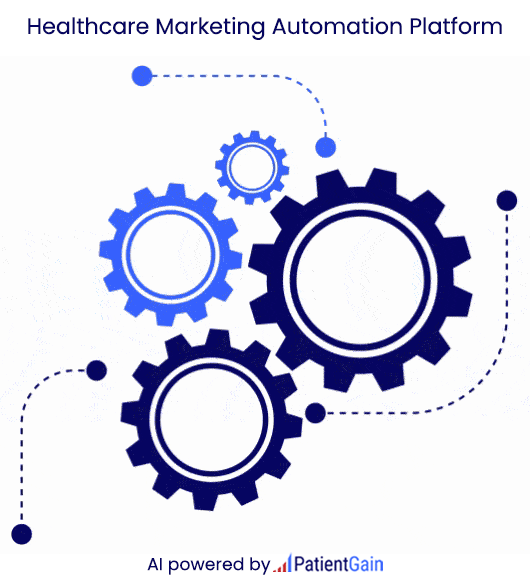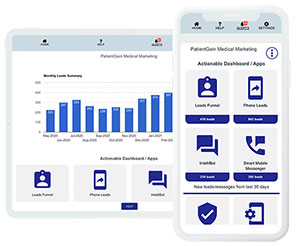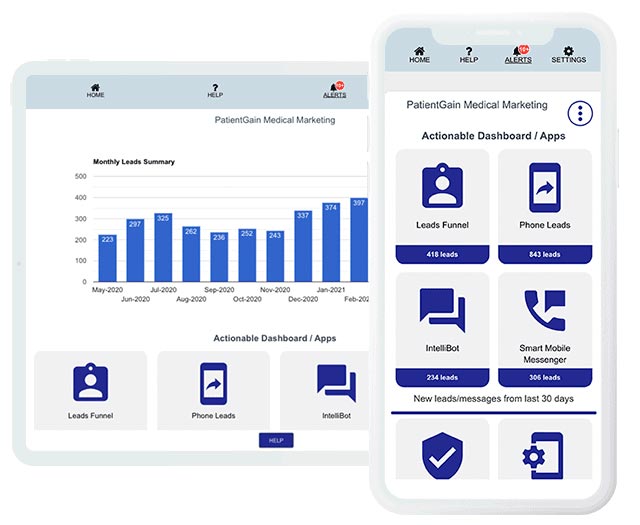Why your medical and dental practice needs advanced real-time AI based medical marketing dashboards (Based on AI Agents and Apps)
Benefits of Real-Time Medical Marketing Dashboards Based on Automation and AI Agents and Apps: Reduce Costs and Improve Patient Acquisition. A live medical marketing dashboard for a practice provides a real-time, centralized view of key performance indicators (KPIs) related to marketing efforts, helping to track and optimize campaign performance, new patient conversions, engagement, and overall medical marketing for your practice. It aggregates data from 20+ applications, AI agents and marketing channels, making it easy to monitor and understand the impact of different strategies.


Common questions asked by dental and medical practice managers: What is a real-time dashboard? What is the advantage of real-time reporting vs. Monthly reports? What are some ways real-time dashboards help different areas of a dental or medical practice? Advantages of real-time dashboards for marketing managers? How does a real-time dashboard help my dental marketing?
For the owner of a dental or medical practice or a practice manager, you likely have some experience with a dashboard. It is a location where all of your data is organized for you to go through, digest, and act on. In some ways, your email provider, as an example, Google Gmail is a bit like a “dashboard”. The emails you receive come in, are organized by rules you set in place, and then you decide what to do with them. Dental or medical practices, if they take their marketing seriously, probably have some dashboards they look at regularly. What many dental practice owners do not have is a live dashboard that populates data in real-time. There are many benefits to this type of dashboard, and they are becoming more common. This is offered and is included in the PatientGain’s PLATINUM service for dental and medical practices. Most healthcare practices use 5 to 8 different apps for their marketing.


Question no 1: What is an advanced real-time medical marketing dashboard with AI insights for medical and dental practices?
There is a lot of data out there for dental and medical practice owners to shift through from many different sources. It can all be overwhelming and challenging to decipher. As an owner of a dental practice, not every scrap of data is valuable, but the data could benefit other people on your staff. Data collected by various sources may be helpful to marketing, doctors, or those at the front desk. It needs to be organized so the correct information gets to the right people and is converted into valuable and actionable values.
The most critical data for each team working in a dental practice should be put in real-time dashboards. It will display essential data, goals, and metrics as they come in. Ideally, it updates automatically throughout the day without any intervention from anyone to “refresh” or “upload new data.” Automatically updating data saves a tremendous amount of time and busy work for your staff. It gives team members the most critical, updated data to make the best decisions at that moment. Medical marketing automation and medical marketing dashboards go hand-in-hand. Medical marketing automation refers to the application of digital tools and technologies to streamline and automate the process of managing online promotions for medical practices. This approach enables practices to efficiently handle tasks like patient outreach, appointment reminders, personalized marketing campaigns, and performance tracking, all while enhancing patient engagement and reducing manual effort.
Example of a live medical marketing dashboard: Dermatology practice. The data is showing number of new patient leads/referrals from medical SEO, medical advertising on Google and medical advertising on social media.

Question no 2: What is the advantage of real-time reporting vs. monthly reports?
Monthly reports are generally not something many people look forward to, other than the people who receive those reports. Reports are time-consuming to put together, for one thing. A department could better spend that time by working on serving or attracting patients. Also, some information will be much more useful throughout the month and not being compiled at the end of the month. If there is a problem with a metric within the first week or two of a month, it will be another two to three weeks before anyone knows about it. For example, it would be nice to see as it happens if:
- The daily PPC budget is running out early every day
- Patient’s per day is not rising with the new marketing campaign
- Site speed is significantly slower
- The time it takes for patients to be seen and discharged is getting longer
- Overall profit per patient is decreasing
This kind of up-to-date information will provide everyone involved with decision-making in that area of responsibility the most up-to-date data needed to make changes. Course corrections can be made quicker, making a dental practice much more efficient. Key performance indicators and other vital metrics should be available to team members at any time as new data comes in. The critical part of this is deciding which information is vital. Not everything can be put into a single dashboard and be practical or functional. These decision-makers need to determine what data they need in real-time to make themselves more efficient. For up to date data and metrics for your dental marketing, you will receive high value out of live-dashboards.
Question no 3: What are some ways real-time dashboards help different areas of a dental practice?
As mentioned above, not all data is helpful in all areas of a dental practice. Effective real-time dashboards are customized for those using them to display data that is most useful for them. Below are some examples of how each area of a dental practice can use real-time dashboards.
Question no 4: What are advantages of a real-time dashboard for business development managers
While not all dental practices have business development managers (BDM), those that do can significantly benefit from a real-time dashboard. Below are some metrics a BDM can keep track of throughout the month on their dashboard.
Example: Performance Reports
A “at a glance” performance report can show a business development managers how their work is progressing this month. Some things to track would be:
- Businesses contacted
- Follow up calls made
- Face to face meetings scheduled
- Contracts signed
- Leads to follow up on
This performance report allows a BDM to quickly gauge how successful they have been this month in their efforts. When a business owner asks the status throughout the month, a BDM can quickly give an accurate picture for them.
Individual Contact Profiles
A BDM can create a profile for each confirmed contact they are working with for those who want more detailed information. This dashboard, before they become confirmed business contacts, would have things like:
- Contact person
- Last contact
- Contact information
- Notes about the business
Once a contractor relationship is established, these metrics may be helpful:
- Patients seen this month
- Revenue per patient
- Total revenue generated
- Top services used
For a BDM, this kind of information will allow them to judge how valuable a relationship is or if they need more work to be more profitable. While 30 days is usually the default for most dashboards, it may be more useful when making long-term evaluations to look at the last 6 to 12 months of data.
Question no 5: What are advantages of Real-time dashboards for marketing managers
Marketing dashboards that provide real-time data are handy for those in charge of marketing. Many dashboards are set up with top key performance indicators (KPIs) updating in real-time for them. The priorities for each marketing manager will be different for each dental practice. The priorities for a marketing manager may change throughout the year. Customization allows them to get the data they need right now for that time of year.
Key Performance Indicators Are Organized In One Place & Always Accessible
KPI’s are critical to marketing managers to gauge the effectiveness of their marketing efforts. These KPIs are also helpful with regular meetings with business owners when planning for future marketing efforts. A real-time dashboard with data that is always accessible and up to date allows for better decision-making. A delay in reporting makes marketing not as agile as possible, causing delays in fixing any issues that may pop up.
It Saves Time & Money With The Better Targeting of Patients
Eliminating the need to put together time-consuming monthly reports, a real-time dashboard frees up more time to engage in other marketing efforts to improve the patient count. Additional time can be put into refining campaign targeting to reach the most valuable potential patients to possible. Data collection, when pulling information from multiple sources and processing it put in a report, is not a good use of time, especially when real-time dashboards are available.
Always Up To Date
Real-time dashboards operate in the cloud, so they are generally accessible from any computer. If there is a question nagging a marketing manager, they can access a dashboard even it is after hours, took a sick day, or out of town at a business conference. Instantly being able to pull updated data on KPIs is a tremendous advantage.
Automated Reporting Allows For Campaign Evaluation and Optimization
Digital campaigns must be monitored to check if they are effective. This monitoring must be continuous. Just because it performed well one week doesn’t mean it will continue to be effective. Automated reporting allows the marketing team to get ongoing updates regarding their digital efforts. As they begin to create and launch new campaigns, this data will help guide their decisions and hopefully avoid past mistakes. Automated reporting also allows them to check on the status of campaigns that are currently running. A dramatic change in stats, KPIs, or other metrics can raise a red flag early, allowing for quick changes or optimizations to course correct a faltering campaign. Problems with digital campaigns are brought to the attention of a marketing manager in real-time instead of finding out about it at the end of a month. Real-time dashboards can be set to alert users when a KPI meets a threshold. For example, if the spam rate for an email campaign hits 3%, an alert can go out so marketing managers can assess the issue.
Question no 6: What are advantages of real-time dashboard for dental practice owners
For the owner of a dental practice, a real-time dashboard is a fantastic tool to make better decisions. Below are some specific examples of how owners can use these dashboards to their advantage.
Access To Real-Time Dashboards of Different Teams
As an example, instead of asking for a report from the marketing department about how campaigns are performing, some owners will pull up their dashboard and take a look. A conversation with a marketing manager will be needed so everyone is on the same page about why specific KPIs are displayed and their importance. An owner can take a look, and if something seems out of the ordinary, they can follow up with them. The same goes for any other area of the dental practice that utilizes a real-time dashboard.
Improved Communications
Access to these dashboards improves internal communications. Instead of a dental practice owner asking for a general report, they can ask for specific information about metrics they see in a dashboard. This allows for targeted reports to be generated, saving everyone time, and getting everyone on the same page about the data in question. Business owners may also find that external communications become more efficient as well. With data more readily available, marketing campaigns can be put together quickly. As a result, helpful, engaging, and informative campaigns can target potential patients easier.
Time Saver
There never seems to be enough hours in the day to accomplish tasks for the owner of a dental practice. Real-time dashboards allow owners to save time and redirect that time to essential projects. Some meetings with those in charge of areas of a dental practice may be eliminated by just reviewing real-time dashboards.
Question no 7: What are some best practices for creating effective live dashboards that have real-time data?
Live, real-time dashboards are usually highly customizable. This is a blessing and a challenge. There are so many options available that if proper planning is not put into its creation, a dashboard can become cumbersome and useless. A large dashboard of constantly updating meaningless information may look fancy but will help no one with their jobs at a dental practice. Instead, employ these best practices to make your dashboard as effective as possible.
Understand who is using the dashboard
Much like creating a Google AdWords campaign, a dashboard needs to be customized for the target audience. The metrics and KPIs for the marketing manager will be inherently different from those needed for the Business Development Manager. Having two identical real-time dashboards for both people will have a lot of information that they will not need to complete their jobs. The best way to determine how to set up a dashboard for areas of the dental practice is to talk to the people who oversee them. Have a conversation with them about what metrics they would like to see and how these metrics would help them in their everyday work.
Utilize Visualizations On A Dashboard
When creating content for a dental practice’s website, you know that images, visuals, colors, graphs, and charts are a great way to convey information quickly. The same principle applies to real-time dashboards. When creating it, employ graphs to display data if it is applicable. Color-code the different tiles, data boxes, and other displays, so the same types of information are organized together. For example, data about patient numbers could be one color while revenue would be another color. Try not to use every color in the rainbow, as that could cause some confusion.
Evaluate Metrics and KPI’s being displayed periodically
Do not make the mistake of not reevaluating your dashboard over time. You may realize that some metrics and KPI’s are not helpful and others would be better suited for the person using the dashboard. As mentioned before, a person should not feel limited to just having one dashboard. For example, a marketing manager may have a particular dashboard created when sending out a direct mail campaign. A traditional marketing campaign may impact metrics and KPI’s that are wholly different than digital campaigns. It is something to consider!
For up to date data and metrics for your dental marketing, you will receive high value out of live-dashboards.
PatientGain.com emphasizes the use of real time HIPAA compliant marketing dashboards as a key component of their services for medical practices.
- Real-time data: They provide real-time dashboards that operate in the cloud, allowing users to access updated data on KPIs (Key Performance Indicators) from any browser/computer or mobile device (iOS and Android).
- Centralized marketing data: The dashboards offer a single location to up to 200 locations to view marketing and advertising results, replacing the need to access multiple applications.
- Performance tracking: They track the performance of marketing campaigns, website traffic, patient engagement metrics, and lead generation.
- Insights and optimization: The dashboards provide insights to help optimize strategies for better ROI.
- HIPAA compliant: The dashboards are designed to be HIPAA compliant. PatientGain offers BAA to all customers who use the HIPAA compliant service.
- Accessibility: Accessible from browser/computer, allowing for access to data even after hours, while sick, or traveling. PatientGain follows very strict security protocols and restricts access to dashboards to only authorized staff of your practice.
- Lead tracking: They track leads from various sources, including website apps, calls, texts, and chat.
- Lead Funnel App: Integrated with a Leads Funnel App and HIPAA-Compliant CRM to track the conversion funnel and calculate patient acquisition cost.
- Support via dashboards: Customers can use the dashboards to contact customer support, which can lead to faster responses. Every practice gets direct access to 2 senior staff members, 1) project managers 2) senior technical staff – both of these staff members assist you. There is no restriction on how many times you contact us and ask questions. We are proud to offer industry’s top customer service to medical and dental practices.
- Example applications: An example shows how an asthma and allergy practice uses the Platinum Service dashboard to monitor leads, website traffic, and ROI, highlighting the effectiveness of their SEO efforts.
- AI and data analytics: PatientGain.com uses AI agents, expert humans and data analytics to optimize marketing campaigns, and their dashboards provide insights into campaign performance.
- Transparency: The dashboards are transparent, showing actual leads, phone calls, and texts coming in. If we manage your Google or social media advertising, you pay directly to Google, Meta etc – we do not mark up keywords.
- Payment tracking: The system tracks online payments and adds the payee information to the dashboards.
- Single platform approach: PatientGain.com’s system replaces multiple vendors with a single platform, with the dashboard serving as a central point for managing online business activities.
In essence, PatientGain.com emphasizes that their dashboards provide a comprehensive, real-time, and HIPAA-compliant view of a medical practice’s marketing performance, helping them track leads, optimize strategies, and make data-driven decisions.
